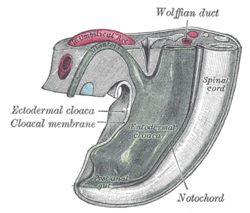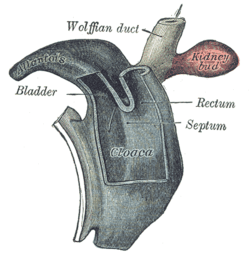Allantois
| Allantois | |
|---|---|
 Diagram illustrating early formation of allantois and differentiation of body-stalk. | |
 Sectional plan of the gravid uterus in the third and fourth month. | |
| Details | |
| Days | 16 |
| Precursor | yolk sac |
| Gives rise to | Umbilical cord |
| Identifiers | |
| Latin | Aallantois |
| MeSH | A10.615.284.147 |
| Code | TE E6.0.1.2.0.0.2 |
Allantois (/əˈlæntɔɪs/; plural allantoides or allantoises) is a sac-like structure that forms part of a developing amniote's conceptus (which consists of all embryonic and extra-embryonic tissues). It helps the embryo exchange gases and handle liquid waste.
The allantois, along with the amnion and chorion (other embryonic membranes), identify humans, and other mammals, as amniotes. Other amniotes include reptiles, dinosaurs, and birds. Of the vertebrates, only Ichthyopsidas (fish and amphibians) lack this structure.
Function
This sac-like structure is primarily involved in nutrition and excretion, and is webbed with blood vessels. The function of the allantois is to collect liquid waste from the embryo, as well as to exchange gases used by the embryo.
In reptiles, birds, and monotremes
The structure first evolved in reptiles and birds as a reservoir for nitrogenous waste, and also as a means for oxygenation of the embryo. Oxygen is absorbed by the allantois through the egg shell.
In most marsupials
In most marsupials, the allantois is avascular, having no blood vessels, but still serves the purpose of storing nitrogenous (NH3) waste. Also, most marsupial allantoises do not fuse with the chorion. An exception is the allantois of the bandicoot, which has a vasculature, and fuses with the chorion.
In placental mammals (Eutheria)
In placental mammals, the allantois is part of and forms an axis for the development of the umbilical cord.
- The mouse allantois consists of mesodermal tissue, which undergoes vasculogenesis to form the mature umbilical artery and vein.[1]
- The human allantois is an endodermal evagination of the developing hindgut which becomes surrounded by the mesodermal connecting stalk. The connecting stalk forms the umbilical vasculature. The allantois becomes the urachus which connects the fetal bladder to the yolk sac. The urachus removes nitrogenous waste from the fetal bladder.[2] The allantois is vestigial and may regress, yet the homologous blood vessels persist as the umbilical arteries and veins connecting the embryo with the placenta.[3]
Clinical significance
During the third week of development, the allantois protrudes into the area of the urogenital sinus. Between the 5th and 7th week of development, the allantois will become the urachus, a duct between the bladder and the yolk sac. A patent allantois can result in urachal cyst.
Etymology
The word comes from the Greek words allanto-, meaning sausage, and eidos, meaning shape or similarity.
Additional images
-

Section through the embryo.
-

Diagram showing later stage of allantoic development with commencing constriction of the yolk-sac.
-

Diagram showing the expansion of amnion and delimitation of the umbilicus.
-

Model of human embryo 1.3 mm. long.
-

Tail end of human embryo from fifteen to eighteen days old.
-

Cloaca of human embryo from twenty-five to twenty-seven days old.
-

Tail end of human embryo twenty-five to twenty-nine days old.
-

Tail end of human embryo thirty-two to thirty-three days old.
-

Ultrasound of fetus showing urachus duct from bladder to the umbilicus.
-

Ultrasound of fetus showing urachus duct from bladder to the umbilicus.
-

Ultrasound of fetus showing urachus duct from bladder to the umbilicus.
-

Ultrasound of fetus showing urachus duct from bladder to the umbilicus.
-

Ultrasound of fetus showing urachus duct from bladder to the umbilicus.
References
- ↑ Downs, K.M. 1998. "The Murine Allantois". Current Topics in Developmental Biology vol. 39, pp 1-33.
- ↑ First AID for the USMLE Step 1 2008
- ↑ http://www.answers.com/topic/allantois
